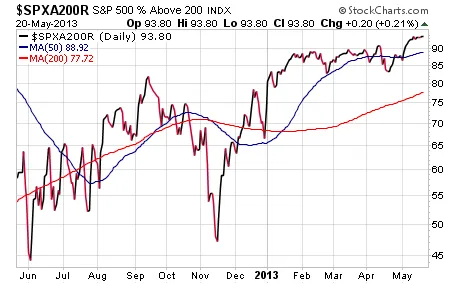Just about every single headline I read these days talks about how the bull market has farther to run, which is making me more and more concerned about the prospects for a pullback. The Fed is onboard, the market is screaming higher, and the bears all seem to be in hibernation. So who is left to buy stocks when everyone is already in?
One of my concerns is that the percentage of S&P 500 stocks above their 200-day moving average is nearing 94%, which represents multi-year highs. This suggests that the buying fervor has been so widespread as to push the entire market to extreme levels.

Typically markets turn when there is no one left to buy, which is why I am starting to pare back on my equity exposure in preparation for a correction. That is not to say that I am calling a top here or selling everything in fear, but I am making subtle changes to my portfolio allocation to get ahead of the curve.
If I am wrong then the only thing I have missed out on is a little bit of upside and I can always reallocate to stocks from cash or short-term fixed income.
Selling Into Strength
One of the strategies you should consider implementing is to look at the most highly appreciated or over weight positions in your portfolio and selling a portion into strength. Often times the ETFs that rise the quickest are some of the hardest hit when the market does come down. Remember that bull markets take the stairs and bear markets take the elevator.
The good people over at ETFdb.com have a list of the best performing ETFs year-to-date, which makes it easy to look at which funds have gained the most. Some of the notable non-leveraged ETFs and their YTD performance are:
Guggenheim Solar ETF (TAN) +63.30%
First Trust NASDAQ Clean Edge Green Energy Index (QCLN) +52.64%
WisdomTree Japan Hedged Equity (DXJ) +41.40%
iShares NASDAQ Biotechnology ETF (IBB) +31.00%
In your own portfolio contains some of these winners, then you may have noticed that their position sizes have become disproportionate to your original allocation. By rebalancing these holdings you can lock in gains and have dry powder available for your next investment opportunity.
Don’t Trade with Taxes In Mind
One funny comment I hear from investors all the time is that “If I sell XYZ fund I am going to have to pay the taxes.” To which I regularly answer “Better to pay the taxes on a gain than owe nothing on a loss.” I would much rather see you sell a portion of your highly appreciated positions into strength when the market is in an up-trend than ride the whims of the next correction or bear market.
Of course this does not apply to IRAs or other tax-deferred investment accounts, which is where you can be more active without having to worry about capital gains and losses.
Taxes are an important consideration, which is why I am a big fan of tax-efficient ETFs, but they should not override your investment decisions when it comes time to make changes to your portfolio.
Have a Stop Loss in Place
One of the mistakes I often see investors make is that they take too big of an allocation to a specific sector or investment theme and then get caught up in a rapid sell-off. All the gold bugs know what I’m talking about.
No matter how well thought out your initial premise was for the trade, you must implement a sell discipline to protect your hard earned capital. Otherwise you may find yourself lying awake at night hoping and praying for a comeback that you may not have the stomach to wait for. Hope is not an investment strategy.
Instead consider placing a stop loss on your holdings to define your risk. You can use a trailing stop loss that automatically moves up when your stock or ETF moves higher. This will allow you to lock in gains (as long as it’s placed above your cost basis) and sleep well at night knowing that you have a portfolio protection plan in place.
The Final Word
As with any investment strategy it is important to have rules and boundaries that define your goals and risk tolerance. Being proactive now will help you transition your portfolio from more aggressive to moderate or conservative as we navigate our way through the balance of 2013.